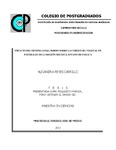Impacto del sistema zanja bordo sobre la cobertura vegetal en pastizales de la región mixteca, estado de Oaxaca.
Abstract
La ganadería intensiva ha provocado pérdidas de la cobertura vegetal que están asociados con procesos erosivos y para atenuarlos, se han establecido acciones de conservación del suelo y agua. El presente trabajo evalúo el impacto del sistema zanja bordo sobre la cobertura vegetal en el pastizal de la cuenca Rancho Dolores de la Región Mixteca del estado de Oaxaca. Los cambios de la cobertura vegetal se identificaron con Índice de Vegetación (NDVI y SAVI) utilizando imágenes de satélite para antes y después de la construcción de las zanjas; con estimaciones de cobertura verde, seca y total, producción de biomasa, e índices de vegetación en tres polígonos con obras y cinco sitios de muestreo (entre zanja, inicio, zanja, bordo y pie) y tres sin obras en tres sitios de muestreo (parte alta, media y baja) y el análisis de la composición florística de la vegetación en pastizales con y sin obras. Los índices de vegetación (NDVI y SAVI) se incrementaron con el establecimiento del sistema zanja bordo. La producción de biomasa en el bordo y la zanja fue de 238.68 g m-2 y 229.84 g m-2 respectivamente y estadísticamente mayores a los sitios de entre zanjas, inicio y pie, los porcentajes de cobertura vegetal, el IVPN, NDVI y SAVI no mostraron diferencias significativas. La entre zanja y testigo mostraron diferencias significativas en la producción de biomasa y el porcentaje de cobertura, los índices de vegetación fueron iguales. En áreas con obras, la especie dominante es Melinis repens (Willd.) Zizka, de potencial forrajero bajo; en áreas testigo la especie dominante es Bouteloua griffithsii Columbus, de potencial forrajero bueno. El Procedimiento de Permutación de Respuesta Múltiple indica que existe diferencia significativa en la composición florística de sitios con obras y testigo. _______________ IMPACT OF THE DITCH BOARD SYSTEM ON THE VEGETATION COVER IN THE GRASSLANDS OF REGION MIXTECA, STATE OAXACA. ABSTRACT: Intensive livestock farming has caused losses of vegetation cover associated with erosion processes and to attenuate them, soil and water conservation actions have been established. The present work evaluated the impact of the ditch board system on the vegetation cover in the grasslands of the Rancho Dolores watershed of the Mixteca Region of the state of Oaxaca. Changes in vegetation cover were identified with Vegetation Indexes (NDVI and SAVI) using satellite images before and after construction of the ditch board; with estimates of green, dry and total cover, biomass production, and Vegetation Indexes’ in three polygons with works and five sampling sites (between trench, start, trench, board and foot) and three without works in three sampling sites (high, medium and low) and the analysis of the floristic composition of the vegetation in grasslands with and without works. Vegetation indices (NDVI and SAVI) were increased with the establishment of the ditch board system. Biomass production at the board and trench was 238.68 g m-2 and 229.84 g m-2 respectively and statistically higher than the sites between trenches, start and foot, the percentages of vegetal cover, IVPN, NDVI and SAVI did not show significant differences. Between trench and control showed significant differences in biomass production and coverage percentage, but the vegetation indexes were the same. In areas with works, the dominant species is Melinis repens (Willd.) Zizka, of low forage potential. In control areas the dominant species is Bouteloua griffithsii Columbus, of good forage potential. The Multiple Response Permutation Procedure indicates that there is a significant difference in the floristic composition of sites with ditch and control.
Collections
- Tesis MC, MT, MP y DC [274]


